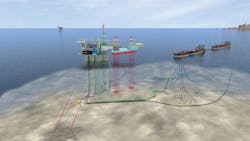Siemens to Build Martin Linge Onshore Substation in Norway
Total E&P Norge AS has contracted Siemens to build the Martin Linge onshore substation in Norway. The Martin Linge oil and gas field will be powered from the Norwegian mainland electrical grid via a new onshore substation located at Kollsnes and built by Siemens. Responsible for the engineering, procurement, supply, construction and commissioning of the onshore facilities, the new Siemens substation will be connected to the platform on the Martin Linge field through a subsea high-voltage alternating-current power and communications cable running 161 km (100 miles). Work begins in the fall, and commissioning of the new substation is targeted for 2015.
Siemens provided an extensive four-month network analysis and system study. The results were used to customize and optimize the layout of the substation, taking into account the challenging requirements of this project. The turnkey project includes 300-kV and 100-kV onshore cables, the substation featuring Siemens’ SVC PLUS (static var compensation), high-voltage transformers, gas-insulated switchgear and substation automation system. The subsea cable will be delivered by a separate contracted partner of Total E&P Norge AS.
The substation will feature duplicate systems, meeting the requirements for the power system at the offshore facilities and the connected 300-kV onshore grid. The design capacity is 55 MW.
The containerized SVC PLUS for reactive power compensation is a cost-efficient, space-saving, flexible solution to increase dynamic stability and power quality of transmission systems, based on multilevel voltage-source converter technology.
SVC PLUS provides operational advantages like minimized maintenance and service requirements, network stabilization, excellent under-voltage performance and high dynamic performance by a very fast response time. It reaches a very high level of system availability, thanks to the redundancy of power modules.
Power from onshore is in line with the Norwegian authorities’ objective to curb CO2 emissions from the offshore oil and gas industry. Oil platforms in Norway are mainly supplied by gas turbines. By supplying energy from onshore solutions, the overall CO2 footprint is reduced, as electricity in Norway is mainly produced in renewable (water) power plants.
For more information, visit www.siemens.com.
